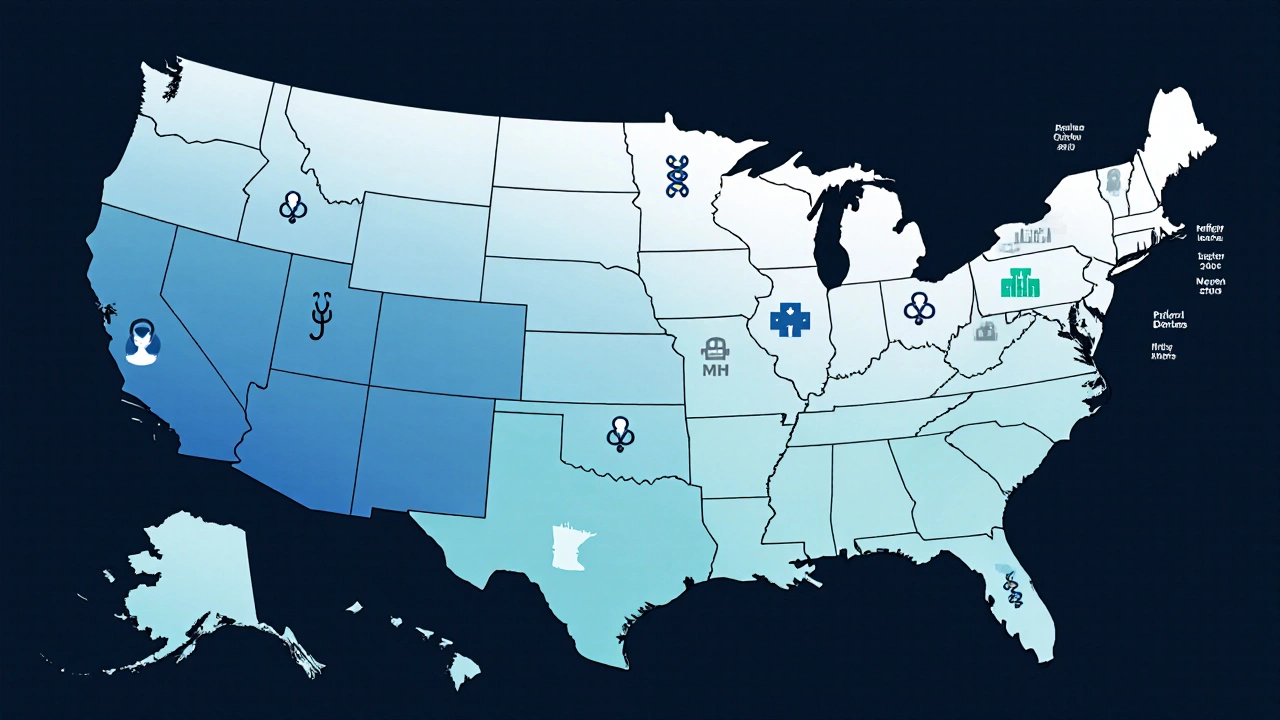- Home
- ::
- Which US State Offers the Best Doctors? A Data‑Driven Look

Which US State Offers the Best Doctors? A Data‑Driven Look
Best Doctors by State - Interactive Explorer
Explore the top 5 states with the best doctors based on key healthcare metrics. Click on any state card to see detailed breakdowns.
Massachusetts
Leader in medical research and teaching hospitals
Minnesota
Home to the Mayo Clinic network
Hawaii
Strong emphasis on preventive care
California
Large, diverse physician pool
Maryland
High concentration of research hospitals near D.C.
Key Metrics Explained
- Doctor-to-Patient Ratio: Number of active physicians per 1,000 residents. Lower ratios often mean more personalized care.
- Hospital Quality Score: Average rating from CMS Hospital Compare data. Higher scores indicate better patient safety and outcomes.
- Patient Outcome Index: Combined measure of 30-day mortality, readmission, and complication rates for major procedures. Lower is better.
- Specialty Coverage: Number of subspecialists per 100,000 residents. Higher numbers indicate better access to niche expertise.
Note: Rankings are based on 2024-2025 data. Healthcare quality can vary significantly within states depending on region, hospital systems, and provider networks.
best doctors by state is a question that pops up whenever someone thinks about moving, seeking specialist care, or even planning a medical‑tourism trip within the United States. The short answer? Some states consistently outshine the rest, but the story behind the numbers matters just as much as the ranking itself.
- Learn which states rank highest for overall physician quality.
- Understand the key metrics that drive those rankings.
- Discover strengths and weaknesses of each top state.
- Get practical tools to locate top doctors wherever you are.
- Avoid common traps when judging doctor performance.
How physician quality is measured across the United States
There isn’t a single "doctor scorecard" that every organization uses, but most reputable studies rely on a blend of the following data points:
- Doctor-to-Patient Ratio (the number of active physicians per 1,000 residents). A lower ratio often translates to more time per patient and better preventive care.
- Patient Outcomes (mortality, readmission, and complication rates for common procedures). Outcomes reflect not just doctor skill but also system‑level coordination.
- Hospital Quality Scores (ratings from agencies like CMS and U.S. News & World Report). Doctors often work in top‑rated hospitals, which boosts overall care quality.
- Specialty Distribution (availability of subspecialists per capita). States with a broader mix of specialties can address rare conditions locally.
- Health‑care spending per capita and insurance coverage rates, which affect access to high‑quality providers.
Two organizations dominate the data pool:
- U.S. News & World Report Rankings (annual list of top hospitals and health systems) aggregates mortality and patient safety metrics.
- Centers for Medicare & Medicaid Services (CMS) (federal agency that publishes Hospital Compare data) supplies standardized outcome measures used by most state‑by‑state studies.
Top 5 states with the best doctors (2024‑2025 data)
| State | Doctor‑to‑Patient Ratio (per 1,000) | Average Hospital Quality Score (CMS) | Patient Outcome Index* (lower is better) | Specialty Coverage (per 100,000) |
|---|---|---|---|---|
| Massachusetts Leader in medical research and teaching hospitals | 2.85 | 92.4 | 0.68 | 210 |
| Minnesota Home to the Mayo Clinic network | 2.73 | 90.7 | 0.71 | 198 |
| Hawaii Strong emphasis on preventive care | 2.66 | 89.9 | 0.73 | 185 |
| California Large, diverse physician pool | 2.59 | 88.5 | 0.78 | 215 |
| Maryland High concentration of research hospitals near D.C. | 2.62 | 88.1 | 0.80 | 192 |
*Patient Outcome Index combines 30‑day mortality, readmission, and complication rates for heart attack, pneumonia, and hip fracture. The lower the number, the better the outcomes.

What makes these states stand out?
Each of the top five states excels in a slightly different way, but a few common threads run through them:
- Academic Medicine Hubs - Massachusetts and Minnesota host world‑renowned medical schools (Harvard, Johns Hopkins, Mayo Clinic). Academic affiliates attract top talent and drive evidence‑based practice.
- Investment in Preventive Care - Hawaii’s public health programs focus on early screenings and community wellness, reducing the burden of chronic disease.
- Robust Specialty Networks - California’s sheer size yields a dense web of subspecialists, making it easier to find niche expertise without traveling far.
- Data‑Driven Hospital Systems - Maryland’s hospitals participate actively in CMS quality improvement initiatives, feeding real‑time performance data back to physicians.
When you combine a low doctor‑to‑patient ratio with high hospital scores and strong specialty coverage, the result is a health ecosystem where patients receive timely, coordinated, and high‑quality care.
How to find top doctors in your state
Even if you don’t live in one of the five headline states, you can still locate excellent physicians. Follow this straightforward process:
- Visit the American Medical Association (AMA) physician finder database and filter by specialty, board certification, and location.
- Cross‑check each candidate’s hospital affiliation on the U.S. News & World Report hospital ranking page. Doctors linked to top‑rated hospitals typically enjoy better support resources.
- Review patient‑reported outcomes on the CMS Hospital Compare website. Look for low readmission and complication rates for the procedures you need.
- Check state medical board disciplinary records (publicly available in most states) to ensure there are no unresolved complaints.
- Schedule a brief consultation (many specialists offer a 15‑minute “meet‑and‑greet”). Use the call to gauge communication style and bedside manner-soft skills matter as much as hard data.

Common pitfalls when judging doctor quality
It’s easy to fall into traps that give a false sense of security. Here are the most frequent mistakes and how to avoid them:
- Relying on star ratings alone. Online review sites can be biased or manipulated. Treat them as a supplemental signal, not the main decision factor.
- Assuming a high number of doctors equals better care. Overcrowding can dilute quality. Look at the doctor‑to‑patient ratio instead of raw counts.
- Ignoring specialty‑specific outcomes. A physician may be excellent overall but not the best for a particular condition. Seek condition‑specific success rates.
- Overlooking insurance compatibility. Even the best doctor won’t help if your plan doesn’t cover them, leading to unexpected out‑of‑pocket costs.
Future trends: where the next "best doctor" states might emerge
Healthcare is evolving fast. Telemedicine, AI‑assisted diagnostics, and value‑based care models are reshaping how quality is measured. Keep an eye on these signals:
- States investing heavily in broadband for rural telehealth (e.g., Utah, North Carolina) may level the playing field.
- Regions adopting bundled‑payment programs early (e.g., Colorado) often see quicker improvements in outcomes.
- States that simplify licensing for out‑of‑state tele‑physicians could attract top talent without geographic constraints.
In short, while the current leaders are clear, the landscape can shift as policy, technology, and funding change.
Frequently Asked Questions
Which state has the highest doctor‑to‑patient ratio?
Massachusetts leads with about 2.85 physicians per 1,000 residents, according to the latest National Center for Health Statistics data.
Do rankings consider only hospital‑based doctors?
No. Reputable studies blend hospital performance scores with outpatient physician data, specialty availability, and patient outcome metrics to capture the full picture.
Can I trust online doctor reviews?
Online reviews are useful for gauging bedside manner but should be paired with objective data like CMS outcome scores and board certification status before making a final decision.
How often do these rankings change?
Major shifts usually occur every 2‑3 years when new hospitals open, large health systems merge, or state policies on Medicaid expansion are revised. Year‑to‑year changes tend to be modest.
I'm moving to a new state-what's the quickest way to verify a doctor’s credentials?
Start with the state medical board’s online license lookup, then confirm board certification through the American Board of Medical Specialties (ABMS) website, and finally check hospital affiliation on CMS Hospital Compare.

 Health and Wellness
Health and Wellness





Write a comment